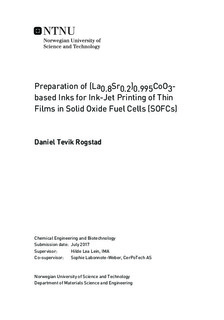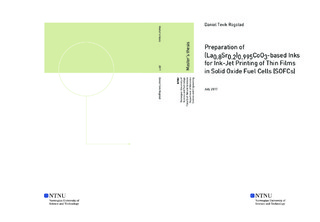| dc.description.abstract | Lanthanum Strontium Cobalt oxide (LSC) is a mixed ionic-electronic conductor (MIEC) ceramic suited for use as cathode material in Solid Oxide Fuel Cells (SOFCs). Extensive research is conducted on producing the cathode in the SOFC as a thin film to reduce operating temperatures and alleviate disadvantageous properties like high thermal expansion coefficient (TEC). One way of producing thin films is through ink-jet printing. Ink-jet printing is a cheap, simple and precise manufacturing method that produces less waste than other deposition methods. It is therefore of interest to explore the feasibility of producing LSC thin films this way. This thesis investigates the possibility of making a stable ceramic ink based on LSC. An LSC powder with the stoichiometry (La0.8Sr0.2)0.995CoO3 was used, produced by CerPoTech AS through spray pyrolysis. The powder was suspended in ten different liquid systems, five based on alpha-Terpineol, Isopropanol and PVP and five based on Ethylene Glycol, Distilled Water and Dolapix CE 64. All inks were characterised to find their particle size distribution, density, viscosity and surface tension. Particle size distribution data gathered over two days were used to evaluate the stability of the inks. The fluid properties were used to evaluate the jettability of the inks by means of the Z-parameter (Ohnesorge reciprocal), the Capillary-Weber parameter space defined by Nallan et al. (2014), and the Weber-Reynolds parameter space as defined by Derby (2003, 2010, 2011, 2015).
Five out of the ten inks were printed onto paper as black squares of different transparency in 1, 2, 3, 4, 5 and 10 layers using an Epson WorkForce WF-2630 commercial office printer with piezoelectric drop on demand (\ac{dod}) inkjet technology. The one- and ten-layered squares were examined using optical and scanning electron microscopy.
The alpha-Terpineol based suspensions showed good stability against agglomeration and sedimentation over a two day period and an accurate deposition of a locally coherent film of LSC-powder was achieved through printing of a 50 wt\% isopropanol suspension with a solid content of 19.3 wt\%. | |

